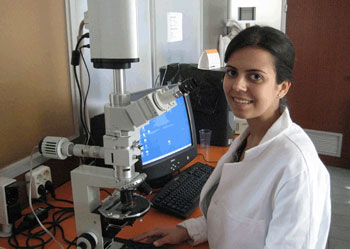| Posted: November 13, 2008 |
Collagen nanofibers for synthetic knee cartilages |
|
(Nanowerk News) The work of Camila Flor, a student at the School of Industrial and Aeronautical Engineering (ETSEIAT), may form the basis for creating, for the first time, synthetic cartilage that is similar to human cartilage and has applications in patients with prostheses.
|
|
In her final project, entitled "A Study of the Formation of Collagen Nanofibers using Electrospinning", Camila Flor, a student at the School of Industrial and Aeronautic Engineering of Terrassa, reports on the manufacturing of synthetic cartilage similar to human cartilage, for medical use. Protection of the knee for disabled people with prostheses may be one of the first applications. The work is part of a macroproject coordinated by the laboratory of Dr. Juan Hinestroza of Cornell University, USA, the creator of bactericidal clothing.
|
 |
| Camila Flor
|
|
Orienting or controlling nanofibers means arraying them in a particular configuration: in parallel, in a circle, or crossed. The fibers that form the cartilage that protects the knee are aligned in parallel. Orienting collagen nanofibers is an extremely complex task because collagen is a natural polymer that is very difficult to control. Camila Flor, a student at the ETSEIAT (UPC), has achieved this using the electrospinning method.
|
|
The results of Camila Flor's work are innovative. The collagen nanofibers are obtained by exposing the collagen to electrical discharges. The collagen is extruded, in the form of a nanofiber thread, through a fine needle and is deposited on an electric collector consisting of two grounded plates. The student placed a nonconductive material between the two conducting plates. The nanofibers aligned on top of each other perfectly in parallel lines between the two conducting plates.
|
|
Camila Flor was very cautious when explaining why the nanofibers had behaved in this manner. According to the student, one hypothesis that explains the phenomenon has to do with the ratio of the diameter of the nanofibers to the distance between the two collecting plates on which they are deposited. Flor believes that the smaller the diameter of the nanofibers, the better the results will be, but she insists that this is a working hypothesis that needs to be thoroughly tested.
|
|
How to manufacture synthetic cartilage
|
|
Until now, creating synthetic cartilage was complex but not impossible. The problem was that it was impossible to imitate the perfection of human cartilage due to the difficulty in orienting the collagen nanofibers; synthetic cartilage was therefore manufactured using gelatinous substances derived from collagen.
|
|
The process for creating synthetic cartilage began with processing stem cells. These cells, if processed in the right way, reproduce and transform into any type of cell required by the scientist manipulating them. For this to be possible, the cells must be in an ideal environment. The work carried out by Camila Flor means that the collagen fibers adapt to the configuration of the chondrocytes (cartilage cells) and are made in the ideal environment, in which these chondrocytes grow until they form the desired cartilage.
|
|
A Cornell University macroproject
|
|
The work by Camila Flor is the result of a final thesis supervised by Dr. Juan Hinestroza of Cornell University, USA, with contributions from Dr. Arun Naik of the UPC's Institute of Textile Research and Industrial Cooperation at the Terrassa Campus, and was carried out within the textile specialization of the Industrial Engineering degree.
|
|
Camila Flor has dedicated months of research and study to the work, which is part of a macroproject, the objective of which is to manufacture synthetic cartilage for medical uses, such as knee protection for patients with protheses. The project, funded by the Morgan Family Tissue Engineering Fund, is being carried out by the laboratory run by the lecturer and researcher Dr. Juan Hinestroza of Cornell University, USA, and is coordinated by Dr. Ryan Kurby and Dr. Margaret Frey . Two US students?a postdoctoral student and a doctoral student?are taking part in the project by carrying out research on stem cells and the manipulation of different types of polymers. Camila Flor, who recently graduated from the ETSEIAT, has managed to orient collagen fibers?a key step that will allow the project to move forward. The next step of the project will be to create the structure obtained by the UPC student in three dimensions so that work can begin on manufacturing cartilage.
|

